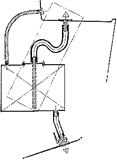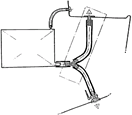HELCOM RECOMMENDATION 22/1
This Recommendation supplements HELCOM Recommendation 19/9
Adopted 21 March 2001, having regard to Article 20(1), b) of the 1992 Helsinki Convention
INSTALLATION OF TOILET RETENTION SYSTEMS AND STANDARD CONNECTIONS FOR SEWAGE ON BOARD EXISTING FISHING VESSELS, WORKING VESSELS AND PLEASURE CRAFT
THE COMMISSION,
RECALLING Article 9 of the Convention on the Protection of the Marine Environment of the Baltic Sea Area, 1992 (the Helsinki Convention) concerning special measures to abate harmful effects on the marine environment of the Baltic Sea area caused by pleasure craft activities,
RECALLING ALSO the Baltic Strategy for Port Reception Facilities for Ship-generated Wastes and Associated Issues as the means to substantially decrease operational discharges and to eliminate illegal disposal of ship-generated wastes and cargo residues into the sea and thus prevent pollution of the Baltic Sea area,
RECALLING FURTHER that, in accordance with HELCOM Recommendation 21/2 a new Regulation 6 is inserted in Annex IV of the Helsinki Convention, which stipulates that all other ships, including pleasure craft, not referred to in paragraph B of Regulation 5 of the Helsinki Convention, built before 1 January 2000 and fitted with a toilet shall comply with the provisions of paragraphs A, C and D of Regulation 5 in Annex IV of the Helsinki Convention as from 1 January 2005,
RECALLING FURTHERMORE that in HELCOM Recommendation 19/9 it is recommended that the Governments of the Contracting Parties ensure that at the date of entry into force of Regulation 7 bis of Annex IV of the 1974, now Regulation 6 of Annex IV of the 1992, Helsinki Convention, toilet retention systems and connections for waste water installed on craft are designed according to the International Standard ISO 8099,
NOTING that there are certain technical difficulties to apply the International Standard ISO 8099 for all existing pleasure craft,
NOTING FURTHER that the Maritime Committee at its 23rd meeting agreed that the Maritime Committee should develop, before the entry into force of the new Regulation 7 bis of Annex IV of the 1974, now Regulation 6 of Annex IV of the 1992, Helsinki Convention, specific guidelines for toilet retention systems which can be fulfilled by pleasure craft built before 1 January 2000 with special emphasis on small pleasure craft,
APPROVES the attached Guidelines, cf. Regulation 6 B and C2 of Annex IV of the Helsinki Convention, to be applied to existing fishing vessels, working vessels and pleasure craft not later than 1.1.2005, cf. Regulation 6 A a) of Annex IV of the Helsinki Convention,
REQUESTS the Governments of the Contracting Parties to report on the implementation of this Recommendation, including the Guidelines in accordance with Article 16(1) of the Helsinki Convention.
ATTACHMENT
GUIDELINES FOR INSTALLATION OF TOILET RETENTION SYSTEMS AND STANDARD CONNECTIONS FOR SEWAGE ON BOARD EXISTING FISHING VESSELS, WORKING VESSELS AND PLEASURE CRAFT
CONTENTS
I Application
II Definitions
III Technical requirements for toilet retention systems in existing craft
IV Installation of deck fittings for draining of holding tanks for sewage in existing craft
V Portable toilets and portable holding tanks
I APPLICATION
The new regulation 6 of Annex IV to the Helsinki Convention stipulates that all ships built before 1 January 2000, including pleasure craft, shall comply with the provisions of paragraphs A, C and D of Regulation 5 on 1 January 2005. This means that all vessels that have a toilet shall have a toilet retention system that can be emptied into the port reception facilities.
In principle the toilet retention systems and connections for waste water installed on craft are to be designed according to International Standard ISO 8099 [1]. There are, however, technical difficulties to apply this Standard to all existing pleasure craft, especially to small craft.
In these guidelines instructions are given for the installation of adequate toilet retention systems and sewage discharge connections in existing vessels that have a toilet without a holding tank or that have a toilet with a holding tank for discharge over board only. Portable toilets, portable holding tanks or other solutions equally effective as retention systems shall remain as an alternative to permanent systems.
The possibility to discharge sewage from holding tanks straight into the water in accordance with discharge regulations for sewage shall still be possible. In this case, the through hull fitting shall be capable of being shut.
II DEFINITIONS
Toilet retention system means: Interconnected sanitation equipment including the toilet, hoses, pipes, a holding tank, and a deck fitting designed for use on board small craft to receive, retain, vent and dispose of sewage.
Deck fitting means: A connection on the deck where the hose of the shore reception facility can be connected for discharge of sewage.
Existing craft means: All ships including fishing vessels, working vessels or pleasure craft built before 1.1.2000 and:
a) less than 200 tons gross tonnage;
b) less than 200 tons gross tonnage and certified to carry not more than 10 persons;
c) with no measured gross tonnage and certified to carry not more than 10 persons.
A portable tank means: A tank which is designed and intended to be removed for disposal of its content.
III TECHNICAL REQUIREMENTS FOR TOILET RETENTION SYSTEMS IN EXISTING CRAFT
The toilet retention system should be constructed, as far as practicable, in compliance with the ISO 8099 Small craft - Waste water retention and treatment - Toilet retention systems.
Technical requirements for holding tanks and discharge hoses
The vent pipe inside diameter should be, depending on the capacity of the tank, according to the ISO 8099 standard, to withstand the suction pressure or alternatively be equipped with a method of adding make-up air via a tank orifice which is opened during pump-out operation.
If sewage remains in the hose, a special type of hose that does not let through odours, should be used.
Technical requirements for deck fittings
For deck discharge connection, a Ø 38 mm opening should be used (if internally threaded, G1½ according to ISO 228-1 should be applied). A Ø 45 mm or 50 mm opening should be accepted as alternatives. The deck fitting should be marked with the appropriate ISO symbol.
The deck fitting hose should run at least 300 mm straight from the deck fitting to allow the pump push-in probe to work properly. The deck fitting should be installed according to the manufacturer's instructions.
Safety
To avoid water being siphoned through the through hull fitting into the craft, a siphon break should be used if the toilet is below waterline or if there is a risk that the edge of the toilet will be below the waterline when the craft is heeling.
IV INSTALLATION OF DECK FITTINGS FOR DRAINING OF HOLDING TANKS FOR SEWAGE IN EXISTING CRAFT
The most common alternatives for installation of deck fittings are given in the following figures. The arrangement depicted in Figure 1 can be considered to be the technically best solution for draining of a holding tank, because the Y-valve arrangement shown in Figures 2 and 3 may become obstructed and it may also easily have a leak.
 |  |  |
| Figure 1. The draining arrangement of a holding tank through an inspection hole. The deck draining hose can easily be installed to the inspection hole cover without dismounting the tank. | Figure 2. The arrangement for draining of a holding tank by installation of a Y-valve between the tank outlet and the through hull fitting. | Figure 3. The arrangement for draining of a holding tank equipped with a discharge pump. A Y-valve that can be shut should be used, if the pump is of a type that cannot withstand suction pressure. |
V PORTABLE TOILETS AND PORTABLE HOLDING TANKS
As an alternative, a portable toilet or a portable holding tank can be accepted, provided that it can be discharged into the shore reception facilities.
Use of chemicals in holding tanks
Only chemicals which are not harmful to the marine environment should be used in permanent or portable holding tanks.
1. When under revision the latest draft ISO standard will be accepted.

